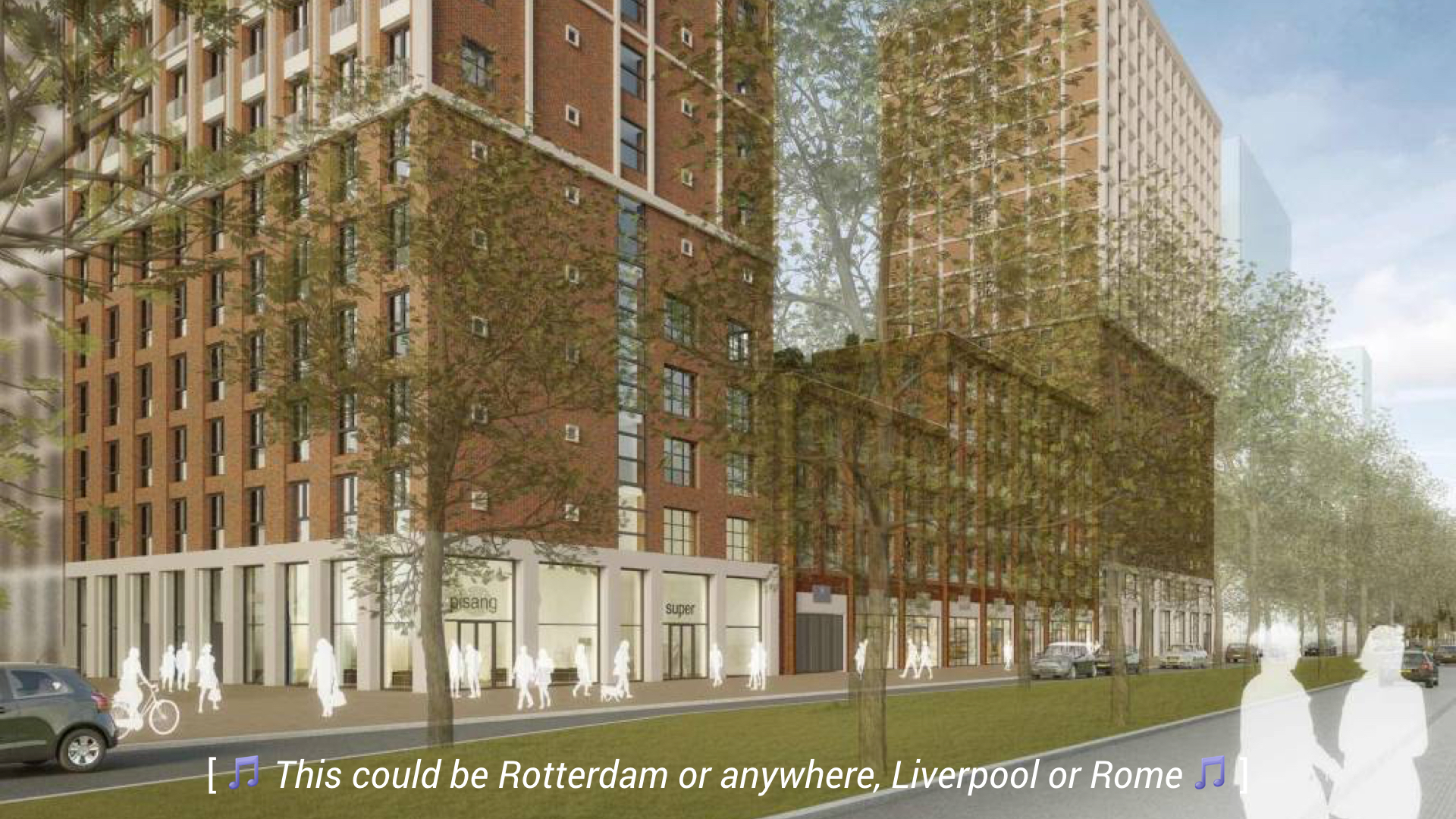
The Potential For Radical Politics in Rendering – Paper delivered at Between Paper and Pixels, Transmedial traffic in architecture drawing at the Jaap Bakema Study Centre, TU Delft. The paper looks at how the aesthetics of rendering software are influencing popular conceptions of the future and offers there categories of radical practice that are challenging this hegemony; Un-Rendering, Low-Rendering and Hyper-Rendering. The abstract is below. The full paper has been blogged here.
Architectural renders form the cornerstone of public communication in contemporary architecture. New developments are reported and promoted to the public using highly stylised glamorous and romantic renders that conform to the dominant societal values and politics: aspiration, wealth, executive and family lifestyles, urbanism. This consequently results in an homogenous aesthetic. Rendering software and its application works as a self-reciprocating aesthetic style of tropes that reinforce these dominant politics and values. Images of the future reinforce the way that future is developed [Bassett et al. 2013] and so in creating these renders, developers and architects build a narrow and linear vision of the future in line with the values they espouse. In tun, the software is further developed to reinforce these tropes. [Plummer Fernandez 2014]
Because of their dominance, projects of resistance cite these renders as targets. Campaigns attempting to halt redevelopment, gentrification or expensive public-private projects hold up these renders as leitmotif effigy, symbols of the top-down power the renders represent.
However, the growing accessibility and usability of rendering software presents an alternative space for political action. Rather than simply becoming sites of resistance, rendering software has the potential to be a site of radical, critical imagination. As Nick Srnicek and Alex Williams point out in their book ‘Inventing the Future’ - We ‘can’t resist new worlds into being’ [Srnicek & Williams 2015] but we can begin to render new worlds as alternative visions that wildly challenge the dominant hegemony of rendered futures.
Activists and artists have begun to use rendering software as a tool for creating new imaginaries and feeling critical debate about the shaping of the future. Their projects challenge histories, the laws of physics and create sprawling meta-fictions that exceed the abilities of other media. At the same time these projects make tongue-in cheek attacks at the narratives and aesthetics of architectural rendering and dominant power structures.
This paper lays out a brief analysis of the relationship between future imaginaries and the dominant aesthetics of contemporary rendering software and suggests that this software presents a space for developing political imaginaries that can lead change and critical discussion. It uses examples and case studies from theorists and artists working in the space of 3D rendering to lay out a framework for where these kinds of practices might start to exist and act and suggests tactics and techniques for a new radical culture of rendering.
11.2016
Architectural renders form the cornerstone of public communication in contemporary architecture. New developments are reported and promoted to the public using highly stylised glamorous and romantic renders that conform to the dominant societal values and politics: aspiration, wealth, executive and family lifestyles, urbanism. This consequently results in an homogenous aesthetic. Rendering software and its application works as a self-reciprocating aesthetic style of tropes that reinforce these dominant politics and values. Images of the future reinforce the way that future is developed [Bassett et al. 2013] and so in creating these renders, developers and architects build a narrow and linear vision of the future in line with the values they espouse. In tun, the software is further developed to reinforce these tropes. [Plummer Fernandez 2014]
Because of their dominance, projects of resistance cite these renders as targets. Campaigns attempting to halt redevelopment, gentrification or expensive public-private projects hold up these renders as leitmotif effigy, symbols of the top-down power the renders represent.
However, the growing accessibility and usability of rendering software presents an alternative space for political action. Rather than simply becoming sites of resistance, rendering software has the potential to be a site of radical, critical imagination. As Nick Srnicek and Alex Williams point out in their book ‘Inventing the Future’ - We ‘can’t resist new worlds into being’ [Srnicek & Williams 2015] but we can begin to render new worlds as alternative visions that wildly challenge the dominant hegemony of rendered futures.
Activists and artists have begun to use rendering software as a tool for creating new imaginaries and feeling critical debate about the shaping of the future. Their projects challenge histories, the laws of physics and create sprawling meta-fictions that exceed the abilities of other media. At the same time these projects make tongue-in cheek attacks at the narratives and aesthetics of architectural rendering and dominant power structures.
This paper lays out a brief analysis of the relationship between future imaginaries and the dominant aesthetics of contemporary rendering software and suggests that this software presents a space for developing political imaginaries that can lead change and critical discussion. It uses examples and case studies from theorists and artists working in the space of 3D rendering to lay out a framework for where these kinds of practices might start to exist and act and suggests tactics and techniques for a new radical culture of rendering.
11.2016